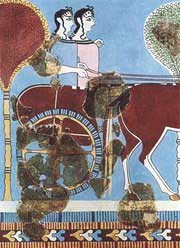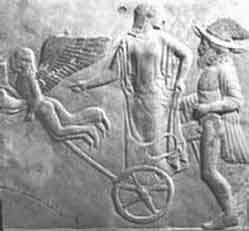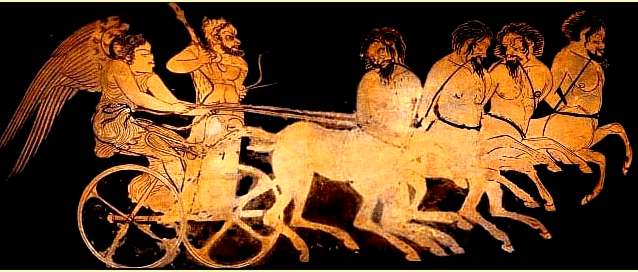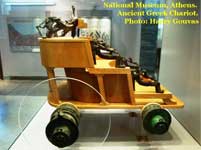.
A chariot is a two-wheeled, horse-drawn vehicle. In Latin biga is a two-horse chariot, and quadriga is a four-horse chariot. It was used for battle during the Bronze and Iron Ages, and continued to be used for travel, processions and in games after it had been superseded militarily. Early forms may also have had four wheels, although these are not usually referred to as chariots. The critical invention that allowed the construction of light, horse-drawn chariots for use in battle was the spoked wheel. In these times, most horses could not support the weight of a man in battle; the original wild horse was a large pony in size. Chariots were effective in war only on fairly flat, open terrain. As horses were gradually bred to be larger and stronger, chariots gave way to cavalry. The earliest spoke-wheeled chariots date to ca. 2000 BC and their usage peaked around 1300 BC (see Battle of Kadesh). Chariot races continued to be popular in Constantinople until the 6th century.
Mycenae

The Mycenaean Greeks made use of chariots in battle. Administrative records in Linear B script , mainly in Knossos, list chariots (wokha) and their spare parts and equipment, and distinguish between assembled and unassembled chariots. The Linear B ideogram for a chariot (B240, D800;DCCC;) is an abstract drawing, showing two four-spoked wheels. The chariots fell out of use with the end of the Mycenaean civilization, and even in the Iliad, the heroes use the chariots merely as a means of transport, and dismount before engaging the enemy. Chariots were retained only for races in the public games, or for processions, without undergoing any alteration apparently, their form continuing to correspond with the description of Homer, though it was lighter in build, having to carry only the charioteer.

Cyprus
Greece, Classical Antiquity

Helios (or Helius) in his Chariot with the horses Pyrois, Eos, Aethon and Phlegon, probably image from a 435 BC krater, British Museum, London
The classical Greeks had a (still not very effective) cavalry, and the rocky terrain of the Greek mainland was unsuited for wheeled vehicles. In spite of this, the chariot retained a high status, memories of its era were handed down in epic poetry, and they were used for races at the Olympic and Panathenaic Games.
Chariot races were held in all panhellenic games.
Greek chariots were made to be drawn by two horses attached to a central pole. If two additional horses were added, they were attached on each side of the main pair by a single bar or trace fastened to the front of the chariot, as may be seen on two prize vases in the British Museum from the Panathenaic Games at Athens, Greece, in which the driver is seated with his feet resting on a board hanging down in front close to the legs of his horses. The biga itself consists of a seat resting on the axle, with a rail at each side to protect the driver from the wheels. Greek chariots appear to have lacked any other attachment for the horses, which would have made turning difficult.
The body or basket of the chariot rested directly on the axle connecting the two wheels. There was no suspension, making this an uncomfortable form of transport. At the front and sides of the basket was a semicircular guard about 3 ft (1 m) high, to give some protection from enemy attack. At the back the basket was open, making it easy to mount and dismount. There was no seat, and generally only enough room for the driver and one passenger.

Athena on a Chariot, 4th century BC, Cyprus
The central pole was probably attached to the middle of the axle, though it appears to spring from the front of the basket. At the end of the pole was the yoke, which consisted of two small saddles fitting the necks of the horses, and fastened by broad bands round the chest. Besides this the harness of each horse consisted of a bridle and a pair of reins. The reins were mostly the same as those in use in the 19th century, and were made of leather and ornamented with studs of ivory or metal. The reins were passed through rings attached to the collar bands or yoke, and were long enough to be tied round the waist of the charioteer to allow him to defend himself.
The wheels and basket of the chariot were usually of wood, strengthened in places with bronze or iron. They had from four to eight spokes and tires of bronze or iron. Most other nations of this time had chariots of similar design to the Greeks, the chief differences being the mountings.
Mythology
Strange Chariots

"No one shall have my daughter," said the old king, "until he proves that he is worthy to be my son-in-law. If you want her, you must come for her in a chariot drawn by a lion and a wild boar. If you come in any other way, she shall not be your wife." And Pelias laughed, and drove the young man out of his palace. Admetus went away feeling very sad; for who had ever heard of harnessing a lion and a wild boar together in a chariot? The bravest man in the world could not do such a thing as that....It was not yet noon when they came to the edge of the woods and saw the sea and the city of Iolcus only a little way off. A golden chariot stood by the roadside as if waiting for them, and the lion and the boar were soon harnessed to it. It was a strange team, and the two beasts tried hard to fight each other; but Apollo lashed them with a whip and tamed them until they lost their fierceness and were ready to mind the rein. Then Admetus climbed into the chariot; and Apollo stood by his side and held the reins and the whip, and drove into Iolcus. James Baldwin, Old Greek Stories

Hermes and his (flying) Chariot

Nike and Hercules and a Centaur Quadriga (look at the barbaric faces of the Centaurs)
Quotes, Remarks
The Iliad describes a chariot race held for Patroclus Iliad 23.
Herodotus calls a wealthy family a tetrippotrophon (able to maintain four horses for a race)

References
Anthony, David W., 1995, Horse, wagon & chariot: Indo-European languages and archaeology, Antiquity Sept/1995
"The Northern Frontier in Pre-Imperial China", Cambridge History of Ancient China (pp. 885-966) ch. 13, Nicolo Di Cosmo
The central pole was probably attached to the middle of the axle, though it appears to spring from the front of the basket. At the end of the pole was the yoke,
Links

The Charioteers of Delphi and Motya
http://www.hindunet.org/saraswati/chariot.html
| Ancient Greece
Science, Technology , Medicine , Warfare, , Biographies , Life , Cities/Places/Maps , Arts , Literature , Philosophy ,Olympics, Mythology , History , Images Medieval Greece / Byzantine Empire Science, Technology, Arts, , Warfare , Literature, Biographies, Icons, History Modern Greece Cities, Islands, Regions, Fauna/Flora ,Biographies , History , Warfare, Science/Technology, Literature, Music , Arts , Film/Actors , Sport , Fashion --- |


